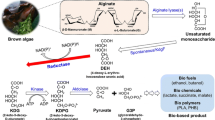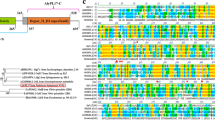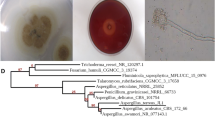Abstract
Despite an increasing potential of red algal biomass as a feedstock, biological conversion of red algal biomass has been limited by lack of feasible microorganisms which can convert structured AHG, which is a main component of red algal carbohydrate, into a common metabolite. In the AHG uptake pathway, AHG dehydrogenase (AHGD) is known to be a key step, therefore it is important to find an efficient dehydrogenase to break down 3,6- anhydro-L-galactose (AHG) for practical use of red macroalgae biomass in biorefineries requires. In this study, we isolate a novel AHG dehydrogenase (AHGD) with high activity produced by a newly isolated bacteria strain, Raoultella ornithinolytica B6–JMP12. The stability and compatibility of the enzyme were evaluated under various conditions to achieve high enzyme production. The AHGD was partially purified using conventional protein purification techniques such as ammonium sulfate precipitation and ion exchange followed by gel filtration chromatography, 37.24 fold with a final specific activity of 5.47 U/mg of protein with 32% yield recovery. SDS-PAGE was used to determine the molecular weight of the partially purified AHGD and its molecular weight was found to be around ~34 kDa. The optimal pH and temperature for the partially purified AHGD were 7.0 and 35°C, respectively. The Km and Vmax for 3,6-anhydro-L-galactose are 0.63 mg/mL and 0.38 μM/mL/min, respectively.
Similar content being viewed by others
References
Kamm, B. and M. Kamm (2004) Principles of biorefineries. Appl. Microbiol. Biotechnol. 64: 137–145.
Goh, C. S. and K. T. Lee (2010) A visionary and conceptual macroalgae-based third-generation bioethanol (TGB) biorefinery in Sabah, Malaysia as an underlay for renewable and sustainable development. Ren. Sustain. Energy Re. 14: 842–848.
Kawai, S. and K. Murata (2016) Biofuel production based on carbohydrates from both brown and red macroalgae: Recent developments in key biotechnologies. Internat. J. Mol. Sci. 17: 145.
Duckworth, M. and W. Yaphe (1971) The structure of agar. Carbohyd. Res. 16: 189–197.
van Rooyen, R., B. Hahn-Hagerdal, D. C. La Grange, and W. H. van Zyl (2005) Construction of cellobiose-growing and fermenting Saccharomyces cerevisiae strains. J. Biotechnol. 120: 284–295.
Lindén, T., J. Peetre, and B. Hahn-Hägerdal (1992) Isolation and characterization of acetic acid-tolerant galactose-fermenting strains of Saccharomyces cerevisiae from a spent sulfite liquor fermentation plant. Appl. Environ. Microbiol. 58: 1661–1669.
Yanase, H., H. Fukushi, N. Ueda, Y. Maeda, A. Toyoda, and K. Tonomura (1991) Cloning, sequencing, and characterization of the intracellular invertase gene from Zymomonas mobilis. Agricult. Biol. Chem. 55: 1383–1390.
Jol, C. N., T. G. Neiss, B. Penninkhof, B. Rudolph, and G. A. De Ruiter (1999) A novel high-performance anion-exchange chromatographic method for the analysis of carrageenans and agars containing 3,6-anhydrogalactose. Anal. Biochem. 268: 213–222.
Lee, D.-G., G.-T. Park, N. Y. Kim, E.-J. Lee, M. K. Jang, Y. G. Shin, G.-S. Park, T.-M. Kim, J.-H. Lee, J. H. Lee, S.-J. Kim, and S.-H. Lee (2006) Cloning, expression, and characterization of a glycoside hydrolase family 50 β-agarase from a marine Agarivorans isolate. Biotechnol. Lett. 28: 1925–1932.
Ohta, Y., Y. Hatada, S. Ito, and K. Horikoshi (2005) High-level expression of a neoagarobiose-producing beta-agarase gene from Agarivorans sp. JAMB-A11 in Bacillus subtilis and enzymic properties of the recombinant enzyme. Biotechnol. Appl. Biochem. 41: 183–191.
Ohta, Y., Y. Hatada, Y. Nogi, Z. Li, S. Ito, and K. Horikoshi (2004) Cloning, expression, and characterization of a glycoside hydrolase family 86 beta-agarase from a deep-sea Microbulbiferlike isolate. Appl. Microbiol. Biotechnol. 66: 266–275.
Ohta, Y., Y. Nogi, M. Miyazaki, Z. Li, Y. Hatada, S. Ito, and K. Horikoshi (2004) Enzymatic properties and nucleotide and amino acid sequences of a thermostable beta-agarase from the novel marine isolate, JAMB-A94. Biosci. Biotechnol. Biochem. 68: 1073–1081.
Ma, C., X. Lu, C. Shi, J. Li, Y. Gu, Y. Ma, Y. Chu, F. Han, Q. Gong, and W. Yu (2007) Molecular cloning and characterization of a novel beta-agarase, AgaB, from marine Pseudoalteromonas sp. CY24. The J. Biol. Chem. 282: 3747–3754.
Ha, J.-C., G.-T. Kim, S.-K. Kim, T. K. Oh, J.-H. Yu, and I.-S. Kong (1997) β-Agarase from Pseudomonas sp. W7: Purification of the recombinant enzyme from Escherichia coli and the effects of salt on its activity. Biotechnol. Appl. Biochem. 26: 1–6.
Lee, S.-B., J.-H. Park, S.-C. Yoon, J.-M. Kim, and I.-S. Kong (2000) Sequence analysis of a β-agarase gene (pjaA) from Pseudomonas sp. isolated from marine environment. J. Biosci. Bioeng. 89: 485–488.
Sugano, Y., I. Terada, M. Arita, M. Noma, and T. Matsumoto (1993) Purification and characterization of a new agarase from a marine bacterium, Vibrio sp. strain JT0107. Appl. Environ. Microbiol. 59: 1549–1554.
Quemener, B. and M. Lahaye (1998) Comparative analysis of sulfated galactans from red algae by reductive hydrolysis and mild methanolysis coupled to two different HPLC techniques. J. Appl. Phycol. 10: 75.
Kendall, K. and J. Cullum (1984) Cloning and expression of an extracellular-agarase from Streptomyces coelicolor A3(2) in Streptomyces lividans 66. Gene 29: 315–321.
Jam, M., D. Flament, J. Allouch, P. Potin, L. Thion, B. Kloareg, M. Czjzek, W. Helbert, G. Michel, and T. Barbeyron (2005) The endo-beta-agarases AgaA and AgaB from the marine bacterium Zobellia galactanivorans: Two paralogue enzymes with different molecular organizations and catalytic behaviours. The Biochem. J. 385: 703–713.
Roh, H., E. J. Yun, S. Lee, H. J. Ko, S. Kim, B. Y. Kim, H. Song, K. I. Lim, K. H. Kim, and I. G. Choi (2012) Genome sequence of Vibrio sp. strain EJY3, an agarolytic marine bacterium metabolizing 3,6-anhydro-L-galactose as a sole carbon source. J. Bacteriol. 194: 2773–2774.
Yun, E. J., S. Lee, H. T. Kim, J. G. Pelton, S. Kim, H. J. Ko, I. G. Choi, and K. H. Kim (2015) The novel catabolic pathway of 3,6-anhydro-L-galactose, the main component of red macroalgae, in a marine bacterium. Environ. Microbiol. 17: 1677–1688.
Lee, S. B., J. A. Kim, and H. S. Lim (2016) Metabolic pathway of 3,6-anhydro-D-galactose in carrageenan-degrading microorganisms. Appl. Microbiol.Biotechnol. 100: 4109–4121.
Paul De Vos, E. (2009) Bergey’s manual of systematic bacteriology. Volume three. The firmicutes. Second edition. Dordrecht, New York, Springer.
Kademi, A., N. Aït-Abdelkader, L. Fakhreddine, and J. Baratti (2000) Purification and characterization of a thermostable esterase from the moderate thermophile Bacillus circulans. Appl. Microbiol. Biotechnol. 54: 173–179.
Laemmli, U. K. (1970) Cleavage of structural proteins during the assembly of the head of bacteriophage T4. Nature 227: 680–685.
Bradford, M. M. (1976) A rapid and sensitive method for the quantitation of microgram quantities of protein utilizing the principle of protein-dye binding. Anal. Biochem. 72: 248–254.
Ye, F., X. Yan, J. Xu, and H. Chen (2006) Determination of aldoses and ketoses by GC-MS using differential derivatisation. Phytochem. Anal.: PCA. 17: 379–383.
O'Neill, A. N. and D. K. R. Stewart (1956) On the structure of agar from gelidium cartilaginium. Can. J. Chem. 34: 1700–1703.
Navarro, D. A. and C. A. Stortz (2003) Determination of the configuration of 3,6-anhydrogalactose and cyclizable alphagalactose 6-sulfate units in red seaweed galactans. Carbohyd. Res. 338: 2111–2118.
Lineweaver, H. and D. Burk (1934) The determination of enzyme dissociation constants. J. Am. Chem. Soc. 56: 658–666.
Kim, K. H., I. G. Choi, E. J. Yun, and S. Y. LEE (2014) Marine bacterium of metabolizing 3,6-anhydro-L-galactose and use of the same. US Patent 8,771,996B2.
Lee, S. B., S. J. Cho, J. A. Kim, S. Y. Lee, S. M. Kim, and H. S. Lim (2014) Metabolic pathway of 3,6-anhydro-L-galactose in agar-degrading microorganisms. Biotechnol. Bioproc. Eng. 19: 866–878.
Author information
Authors and Affiliations
Corresponding author
Rights and permissions
About this article
Cite this article
Oh, Y.R., Jung, K.A., Lee, H.J. et al. A Novel 3,6-anhydro-L-galactose Dehydrogenase Produced by a Newly Isolated Raoultella ornithinolytica B6-JMP12. Biotechnol Bioproc E 23, 64–71 (2018). https://doi.org/10.1007/s12257-017-0480-x
Received:
Revised:
Accepted:
Published:
Issue Date:
DOI: https://doi.org/10.1007/s12257-017-0480-x




